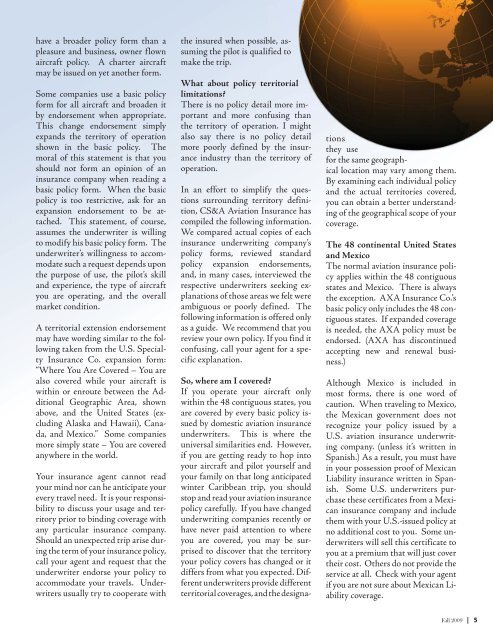800.999.1109 - Aviation Insurance & Risk Management Magazine
800.999.1109 - Aviation Insurance & Risk Management Magazine
800.999.1109 - Aviation Insurance & Risk Management Magazine
Create successful ePaper yourself
Turn your PDF publications into a flip-book with our unique Google optimized e-Paper software.
have a broader policy form than a<br />
pleasure and business, owner flown<br />
aircraft policy. A charter aircraft<br />
may be issued on yet another form.<br />
Some companies use a basic policy<br />
form for all aircraft and broaden it<br />
by endorsement when appropriate.<br />
This change endorsement simply<br />
expands the territory of operation<br />
shown in the basic policy. The<br />
moral of this statement is that you<br />
should not form an opinion of an<br />
insurance company when reading a<br />
basic policy form. When the basic<br />
policy is too restrictive, ask for an<br />
expansion endorsement to be attached.<br />
This statement, of course,<br />
assumes the underwriter is willing<br />
to modify his basic policy form. The<br />
underwriter’s willingness to accommodate<br />
such a request depends upon<br />
the purpose of use, the pilot’s skill<br />
and experience, the type of aircraft<br />
you are operating, and the overall<br />
market condition.<br />
A territorial extension endorsement<br />
may have wording similar to the following<br />
taken from the U.S. Specialty<br />
<strong>Insurance</strong> Co. expansion form:<br />
“Where You Are Covered – You are<br />
also covered while your aircraft is<br />
within or enroute between the Additional<br />
Geographic Area, shown<br />
above, and the United States (excluding<br />
Alaska and Hawaii), Canada,<br />
and Mexico.” Some companies<br />
more simply state – You are covered<br />
anywhere in the world.<br />
Your insurance agent cannot read<br />
your mind nor can he anticipate your<br />
every travel need. It is your responsibility<br />
to discuss your usage and territory<br />
prior to binding coverage with<br />
any particular insurance company.<br />
Should an unexpected trip arise during<br />
the term of your insurance policy,<br />
call your agent and request that the<br />
underwriter endorse your policy to<br />
accommodate your travels. Underwriters<br />
usually try to cooperate with<br />
the insured when possible, assuming<br />
the pilot is qualified to<br />
make the trip.<br />
What about policy territorial<br />
limitations?<br />
There is no policy detail more important<br />
and more confusing than<br />
the territory of operation. I might<br />
also say there is no policy detail<br />
more poorly defined by the insurance<br />
industry than the territory of<br />
operation.<br />
In an effort to simplify the questions<br />
surrounding territory definition,<br />
CS&A <strong>Aviation</strong> <strong>Insurance</strong> has<br />
compiled the following information.<br />
We compared actual copies of each<br />
insurance underwriting company’s<br />
policy forms, reviewed standard<br />
policy expansion endorsements,<br />
and, in many cases, interviewed the<br />
respective underwriters seeking explanations<br />
of those areas we felt were<br />
ambiguous or poorly defined. The<br />
following information is offered only<br />
as a guide. We recommend that you<br />
review your own policy. If you find it<br />
confusing, call your agent for a specific<br />
explanation.<br />
So, where am I covered?<br />
If you operate your aircraft only<br />
within the 48 contiguous states, you<br />
are covered by every basic policy issued<br />
by domestic aviation insurance<br />
underwriters. This is where the<br />
universal similarities end. However,<br />
if you are getting ready to hop into<br />
your aircraft and pilot yourself and<br />
your family on that long anticipated<br />
winter Caribbean trip, you should<br />
stop and read your aviation insurance<br />
policy carefully. If you have changed<br />
underwriting companies recently or<br />
have never paid attention to where<br />
you are covered, you may be surprised<br />
to discover that the territory<br />
your policy covers has changed or it<br />
differs from what you expected. Different<br />
underwriters provide different<br />
territorial coverages, and the designa-<br />
tions<br />
they use<br />
for the same geographical<br />
location may vary among them.<br />
By examining each individual policy<br />
and the actual territories covered,<br />
you can obtain a better understanding<br />
of the geographical scope of your<br />
coverage.<br />
The 48 continental United States<br />
and Mexico<br />
The normal aviation insurance policy<br />
applies within the 48 contiguous<br />
states and Mexico. There is always<br />
the exception. AXA <strong>Insurance</strong> Co.’s<br />
basic policy only includes the 48 contiguous<br />
states. If expanded coverage<br />
is needed, the AXA policy must be<br />
endorsed. (AXA has discontinued<br />
accepting new and renewal business.)<br />
Although Mexico is included in<br />
most forms, there is one word of<br />
caution. When traveling to Mexico,<br />
the Mexican government does not<br />
recognize your policy issued by a<br />
U.S. aviation insurance underwriting<br />
company. (unless it’s written in<br />
Spanish.) As a result, you must have<br />
in your possession proof of Mexican<br />
Liability insurance written in Spanish.<br />
Some U.S. underwriters purchase<br />
these certificates from a Mexican<br />
insurance company and include<br />
them with your U.S.-issued policy at<br />
no additional cost to you. Some underwriters<br />
will sell this certificate to<br />
you at a premium that will just cover<br />
their cost. Others do not provide the<br />
service at all. Check with your agent<br />
if you are not sure about Mexican Liability<br />
coverage.<br />
Fall 2009 | 5



